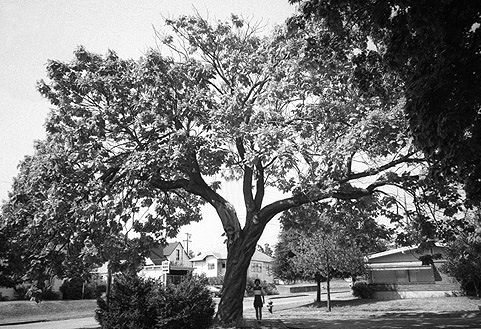
|
Rare Catalpa tree in Ballard
|
| For several weeks in summer Catalpa trees produce dramatic
displays of white flowers in gigantic clusters. They're unmistakable in their
glory. The name is derived from a native American (Muskogean) name
kutuhlpa, meaning a head with wings, referring to the flower shape. The trees
grow rapidly, bear large leaves of bold, tropical texture, and showy
flowers looking like popcorn. The faintly fragrant flowers then give rise
to seedpods which resemble beans, but are full of dry, winged seeds. As
the green leaves turn yellowish and drop in autumn, the seedpods
keep dangling, well into winter, falling gradually. Many people who love
the Catalpa flowers, as well as its handsome big green leaves and fall
color --hate the messy seedpods. |
| Adams School in Ballard and the playground next to it, boasts
19 Catalpas. There are several kinds: native American, east Asian,
and hybrids. The largest of all is unique, and worth a visit. For it is
essentially podless. Its flowers have female parts, but the male counterparts
somehow got changed from sexual potency to floral decorations.
Specifically, the stamens turned into petals or petal-like affairs. As a result, the
tree lacks fragrance and bears few pods or none. In isolation the tree
would probably bear no pods, but since 18 fertile Catalpas are within easy
bee-range, some pollenization occurs. |
| The podless tree doesn't need to expend energy producing pods, so
it has grown larger than any of its neighboring Catalpas. More than 45
feet tall and 65 feet wide, its trunk is more than 3 feet thick. But it shows
the signs of age. Its trunk leans; the strongly spiralled bark reveals
some wounds; an English laurel grows out of its rotting top. |
| Go take a look. It's at the corner of 28th Avenue NW & NW
62nd Street (a few blocks from the Ballard locks). By late July this
podless Catalpa was in bloom, and its large lovely clusters of off-white
flowers should last at least into late August. |
This tree is a hybrid Catalpa, and appears to be the clone 'Adina'.
One parent was from east Asia, the other from eastern North
America. Nobody has documented where or when the hybrid originated, but in
all likelihood it arose in Europe in the late 1800s. What the name
'Adina' means is also wholly mysterious. There used to be another
'Adina' specimen at the U.W., but it fell down. Presently, I don't know of
another podless Catalpa on the West Coast. So plant propagators should
graft twigs from this Ballard tree, or root some from cuttings. If the tree
should collapse before it is propagated, (Seattle School District had it cut down . . . before it could be propagated) we will have lost the chance.
|
(originally published in The Seattle Weekly, August 1996)
Back |
|
|

